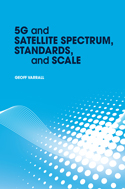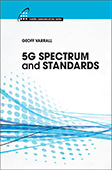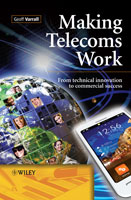RTT Books
 5G and Satellite RF and Optical integration
5G and Satellite RF and Optical integration
This book addresses the integration of RF and optical engineering in terrestrial fixed and mobile networks, space networks and sub orbital communication systems (Low Altitude Platforms and High-Altitude Platforms). It is written to help optical engineers to understand RF engineering and RF engineers to understand the optical technologies used in fixed and mobile networks, including local and long-distance fiber, free space terrestrial optical point to links, earth to space and space to earth links and inter satellite and inter-constellation cross connect.The book shows how to mix and match RF and optical bearers efficiently and explains how to repurpose terrestrial RF and terrestrial optical for space deployment. You’ll learn how to decide whether to use an RF or optical link; how to calculate an RF and optical link budget; how to interface an optical signal to an RF bearer – and vice versa; how to multiplex RF and optical signals in guided and unguided media; and much more. This is a must-have resource for practicing RF engineers, optical engineers, and planners of satcom and terrestrial networks, supply chain partners to 5G/satellite RF/optical integrations needing understanding of problems and solutions. It is also accessible to readers with a market, financial and/or regulatory interest. For more information and to order go to
https://uk.artechhouse.com/5G-and-Satellite-RF-and-Optical-Integration-P2194.aspx
 5G and Satellite Spectrum, Standards and Scale
5G and Satellite Spectrum, Standards and Scale
5G and Satellite Spectrum, Standards and Scale analyses the emerging role of Low Earth Orbit (LEO), Medium Earth Orbit (MEO), and Geostationary satellites (GSO) as a delivery option for backhaul and wide area rural and urban mobile broadband and fixed access. The book offers insight into recently established Non Terrestrial Network standards. Readers learn which bands will need to be supported in next generation 5G and satellite devices and networks and how the bands will be characterized. Channel spacing, guard bands, FDD or TDD, out of band emission limits, and in band performance requirements are discussed. The book discusses what interference issues will arise from new band allocations including co-shared allocations and how interference will be mitigated in and between next generation terrestrial and satellite 5G networks. Readers learn how modulation choices will affect co-existence issues.
The book discusses the design, performance, cost, and test implications of integrating next generation satellite physical and MAC layers with Release 16 and 17 5G standards and explores how these emerging spectrum and standards map on to IOT and MTC use cases in specific vertical markets. Readers learn how new active and passive antennas in the K bands and V and W band (E band) impact the satellite link budget and satellite delivery cost economics.
5G and Satellite Spectrum, Standards and Scale is now available from Artech House.
http://uk.artechhouse.com/5G-and-Satellite-Spectrum-Standards-and-Scale-P1935.aspx
 5G Spectrum and Standards
5G Spectrum and Standards
5G spectrum and standards analyses the spectrum, band plan and standards choices for 5G radio systems and the relative technology and economic impact of these choices on the industry supply chain, operator community and end users. It divides the spectrum into three blocks defined by wavelength rather than frequency – the metre band (300 MHz to 3 GHz), the centimetre band (3 GHz to 30 GHz), and the millimetre band (30 to 300 GHz). Present and future coexistence issues in these bands are analysed including mobile broadband coexistence with terrestrial broadcasting in the metre band, coexistence with fixed point to point and satellite/mobile service satellite and radar in the centimetre band and co-existence with automotive radar and military sub space radio in the millimetre band. Case studies are included of existing local area Wi Fi ‘5G systems’ at 60 GHz (5mm wavelength) and used to highlight the wavelength and technology requirements needed to scale these local area systems to deliver economic wide area high data rate mobile and fixed access connectivity.
The present spectral allocation process is reviewed including the ITU and CEPT and how this process relates to spectrum auctions and regulatory policy and standards making across the traditionally separate industries of mobile broadband, terrestrial broadcasting, and military and consumer satellite and radar.
The outcomes of the two World Radio Congresses in 2012 and 2015 (WRC 2012 and WRC 2015) are analysed together with the agreed study items for WRC 2019.
The present regulatory balance between sovereign responsibility and regional and global policy making is studied in the context of present and future social and economic change including the present balance between licensed, lightly licensed and unlicensed spectrum.
The final chapter argues the case for mixed use approaches to spectrum allocation (analogous to present satellite mixed payload platforms) with the potential to provide the basis of a new generation of collaborative mutual interest business models which could transform the delivery economics of the 5G mobile broadband sector.
5G spectrum and standards is available to order from
http://www.artechhouse.com/International/Books/5G-Spectrum-and-Standards-2327.aspx
 Making Telecoms Work – from technical innovation to commercial success.
Making Telecoms Work – from technical innovation to commercial success.
Bridging the industry divide between the technical expertise of engineers and the aims of market and business planners, Making Telecoms Work provides a basis for the interdisciplinary analysis of technology, engineering, market and business investment risk and opportunity.
Since mobile broadband has become a dominant deliverable, multiple areas of transition and transformation have occurred; the book places these changes in the context of the political, social and economic dynamics of global telecommunications.
Drawing on 25 years of participative experience in the mobile phone and telecommunications industry, the author closely analyses the materials, components and devices that have had a transformative impact.
By presenting detailed case studies of materials innovation, such as those shown at success story Apple, the book shows how the collaboration of technological imagination with business knowledge will shape the industry’s future.
- Makes a link between the technical aspects and the business practice of the telecoms industry, highlighting the commercial and economic significance of new developments.
- Gives a historical analysis of past successes and failures in order to identify future competitive advantage opportunities.
- Supplies detailed case studies of supply chain disconnects and the impact these have on industry risk and profitability.
- Brings together technological detail with analysis of what is and is not commercially important, from the implications of energy and environmental networks to the technical details of wireless network hardware.
Available from John
Wiley or from Amazon or the American Book Exchange
ISBN 1119976413
 3G
Handset and Network Design
3G
Handset and Network Design
3G Handset and Network Design provides a comprehensive introduction to handset hardware, handset software and network hardware and software design.
The book was written in 2002 and published in 2003 but is still relevant and of interest to engineers involved in bringing 3G products and services to market.
We benchmark the impact of the physical layer and the application layer on handset design, how the changing form factor of handsets will change offered traffic loading over the next three to five years (most of our forecasts were right) and how this in turn influences network component design.
The book is also of interest to computing and data networking professionals needing to understand the practical issues of implementing mobile multi media.
Available from John
Wiley or from Amazon
or the American Book Exchange
ISBN 0 471 22936 9
 Data
Over Radio
Data
Over Radio
Co authored by Geoff Varrall and Roger Belcher and published by Quantum Publishing in 1992, Data Over Radio reviews fundamental RF device technology, baseband processing techniques, modulation and channel coding and spread spectrum theory and practice.
Available from Amazon
and American Book Exchange
ISBN 0 930633-14-8
 Mobile
Radio Servicing Handbook
Mobile
Radio Servicing Handbook
Co authored by Geoff Varrall, Roger Belcher, David Ogley and Mike Fitch and published by Heinemann Newnes in 1989 the Mobile Radio Servicing Handbook reviews propagation and frequency utilisation, the principles and practice of RF communication, frequency synthesiser circuit principles, principles of RF measurement, calibration, test and fault finding, component identification and handling, EMC issues in design and antenna selection, installation, fault finding and maintenance.
Available from Amazon
and American Book Exchange
ISBN 0 434 92187-4
Contact geoff@rttonline.com
